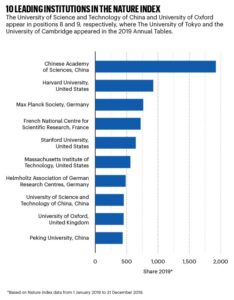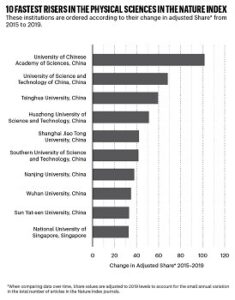
Views: 70
– These institutions achieved the highest overall research output in the Nature Index.
Minapim by Hernan Valenzuela: The Chinese Academy of Sciences (CAS) in Beijing topped the list of the Nature 2020 Index as the most prolific producer of research published in the 82 selected journals crawled by the Index. 
-
- Chinese Academy of Sciences (CAS) China
- Harvard University, United States of America (USA)
- Max Planck Society ,Germany
- French National Centre for Scientific Research (CNRS)
- Stanford University, United States of America (USA)
- Massachusetts Institute of Technology (MIT), United States of America (USA)
- Helmholtz Association of German Research Centres, Germany
- University of Science and Technology of China (USTC), China
- University of Oxford, United Kingdom (UK)
- Peking University (PKU), China
- The University of Tokyo (UTokyo) ,Japan
- Tsinghua University,China
- Nanjing University (NJU),China
- University of Cambridge,United Kingdom (UK)
- University of Chinese Academy of Sciences (UCAS),China
- Swiss Federal Institute of Technology Zurich (ETH Zurich),Switzerland
- National Institutes of Health (NIH), United States of America (USA)
- University of California, Berkeley (UC Berkeley), United States of America (USA)
- University of Michigan (U-M), United States of America (USA)
- University of California, San Diego (UC San Diego), United States of America (USA)
CAS’s participation of 1805.22 in 2019 was almost double that of Harvard University in Cambridge, Massachusetts, which came in second place. Research institutions from China, the United States, France, Germany and the United Kingdom are among the ten most prolific institutions in the 2019 to 2020 Index.
The Nature Index uses an entity’s contribution to articles in the 82 journals tracked by the index as a counting measure, calculated according to the proportion of its affiliated authors in an article relating to all, when comparing data over time, Stock values are adjusted to 2019 levels to account for the small annual variation in the total number of articles in the Nature Index journals.
Rising stars in the physical sciences 2020
These institutions have achieved high increases in research production in the Nature Index since 2015.
1- The Academy of Sciences of the University of China (UCAS), in Beijing, is the fastest growing institution in physical science research in the Nature 2020 Index. Its change in the Adjusted Share from 2015 to 2019 was 101.67, representing an increase of 353.5% in 4 years.
2- Huazhong University of Science and Technology, China
Located in the city of Wuhan, China, Huazhong University of Science and Technology (HUST) has long been considered one of the country’s leading engineering colleges, with strengths in mechanical, electronic and optical engineering.
3- Wuhan University, China
The WHU School of Physics and Technology conducts cutting-edge studies in basic research and engineering. In June 2019, it had received nearly 250 million yuan ($ 35.2 million) in research grants.
4- National University of Singapore
Founded in 1905, the National University of Singapore (NUS) is the oldest institution of higher education in the country.
5- Tianjin University, China
Established in the metropolis of Tianjin, China, in 1895, Tianjin University claims to be the oldest modern-style university in the country. With strengths in chemical and engineering research, he specializes in battery technology innovation research. In 2019, a team from Tianjin University published papers on alternatives to lithium batteries, such as sodium ion and zinc-air batteries.
6- South China University of Technology, China
Located in Guangzhou, capital of Guangdong province and the third largest city in mainland China, with a population of 14 million, the University of Technology of South China (SCUT) is in the heart of one of the country’s largest economic centers.
The ten leading countries in natural science research
The United States is the most prolific editor of high-quality natural science research in the Nature Index, but China is closing the gap with remarkable speed.
In the Nature 2020 index, the United States’ share is 20,152.48, which represents a 4.2% reduction in adjusted production compared to the previous year. China’s share, on the other hand, jumped from 11,372.26 to 13,566.11 in the same period, an increase of 15.4%.
1- United States
The United States’ Share in the Nature index fell slightly in 2019, but continues to be strengthened by its best performing institutes: Harvard University in Cambridge, Massachusetts; Stanford University in Stanford, California; the Massachusetts Institute of Technology in Cambridge, Massachusetts; and the National Institutes of Health. In the Nature 2020 Index, the United States led the ranking in life, physics, Earth and environmental sciences.
2- China
China is the second strongest and fastest growing country in the Nature 2020 Index.
The country’s top performing institutions in all disciplines of the natural sciences are the Chinese Academy of Sciences in Beijing, the China University of Science and Technology in Hefei, the Peking University in Beijing, the Tsinghua University in Beijing and the University from Nanjing to Nanjing, they are all among the top 25 global institutions in the Nature Index. In the 2020 index, China led the ranking in chemistry.
3- Germany
With two institutions among the top ten global institutions on the Nature index, Germany is a force in publishing high-quality research.
Its most prolific institution in the Nature Index, the Munich-based Max Planck Society, ranked in the top 5 in the physical sciences, chemistry and life sciences categories in the 2020 index and ranked third overall.
Germany is home to more than 1,000 publicly funded research institutions and around 400 higher education institutions that contribute to its status of destiny desired by the researchers. It also has a relatively low cost of living, stable growth and high spending on research and development (R&D).
4- United Kingdom
As Nature reported in January, Brexit has already stopped research in the UK. That said, the country remains one of the best in the world in producing high quality research in the natural sciences, maintaining its fourth position in the table of the 50 countries / territories in the Nature Index.
The main UK institutions in the Nature Index include the University of Cambridge and the University of Oxford, ranked among the top 25 global institutions in the 2020 index, and Imperial College London and University College London, 48 and 50, respectively.
5- Japan
Japan is working hard to maintain its position in the global research ranks. As the Nature Index reported in 2019, its strategy of funding selected institutions to increase its collaboration abroad has begun to bear fruit, as the country continues to look outward in an effort to stem the decline in its production of high-profile scientific research. quality. The best performing institutes in Japan are the University of Tokyo, the University of Kyoto, the University of Osaka and the Tokyo Institute of Technology.
6- France
France’s strengths in the natural sciences are diverse, with chemistry, the physical sciences and the life sciences accounting for roughly equal shares in its production of high-quality research, followed by earth and environmental sciences.
In 2019, its best performing institute, the French National Center for Scientific Research (CNRS) in Paris, had more than six times the participation of its second best performing institute, the University of Sorbonne (ranked 127th), also based in Paris.
7- Canada
Canada is one of several high-ranking countries that has experienced a drop in the annual tables of the Share in Nature index, 2020, but has consistently ranked seventh since 2015.
Among the best performing institutions in the country are the University of Toronto, McGill University in Montreal and the University of British Columbia in Vancouver. Its most favored research partners in 2019 were the United States, China and the United Kingdom.
8- Switzerland
For a nation of just 8.4 million people, Switzerland’s high-quality research output is impressive. In the annual tables of the Index 2020, it is the seventh fastest growing country in the world.
The Swiss Federal Institute of Technology Zurich (ETH Zurich) and the Swiss Federal Institute of Technology Lausanne (EPFL) are the best performing institutions in the country in the Nature Index.
9- South Korea
South Korea is one of the most innovative countries in the world, according to the Global Innovation Index. It spends 4.3% of its gross domestic product on R&D.
In the Nature Index, it is one of the main players in chemistry and physical sciences, which together represent more than 95% of its total participation.
South Korea’s biggest collaborative partners in 2019 were the United States, China and Japan. Seoul National University and the Korea Advanced Institute of Science and Technology in Daejeon are its best performers on the 2020 Index.
10- Australia
Australia maintained its position as the tenth largest producer of natural science research in the Index for two consecutive years.
Monash University in Melbourne is the Australian institution with the best performance in terms of production in the 82 selected journals tracked by the Nature Index, followed by the University of New South Wales in Sydney and the University of Queensland in Brisbane.
Source: Nature Research Journal
Related article: The Top 10 Research Institutions Wide World
